- Home
- Michael Byrnes
The Sacred Bones Page 8
The Sacred Bones Read online
Page 8
Turning away, his thoughts shifted to the crypt hidden deep beneath his feet, and the mysterious theft that had once again brought bloodshed to this place. When he'd arrived here yesterday afternoon, he had never anticipated that a situation of such gravity would have allied him with a man like Graham Barton.
At the mosque entrance Razak put on his shoes and made his way outside.
He still had a couple more hours until his meeting with Barton. So he strolled down into the Muslim Quarter and had coffee and breakfast at a small cafe on Via Dolorosa. There, he met some old acquaintances and caught up on all that had happened since his last visit. Naturally, the conversation gravitated to the theft, but Razak was quick to point out that he couldn't comment on the investigation.
By nine a.m., there wasn't the slightest breeze as he crossed the Temple Mount esplanade beneath a scorching sun and descended into the Marwani Mosque. Climbing through the blast hole into the crypt, Akbar-- the oversized Muslim guard instructed to watch over Barton-- signaled that everything was fine. Razak nodded and waved him out into the mosque.
Graham Barton was crouched in a corner transcribing an inscription on one of the ossuaries.
"Good morning, Mr. Barton," Razak said in English.
The archaeologist sprung to his feet.
"Looks like you've been busy." Razak eyed the small stacks of rubbings Barton had laid out at intervals along the floor.
"Very much so," Barton replied cheerily. "I got here early and Akbar was kind enough to let me get a head start."
"What have you found out so far?"
"It's an extraordinary discovery. This crypt belonged to a Jewish man named Yosef." Barton pointed to a box on one end, just as plain as the others. "You'll notice that each of these ossuaries is inscribed in Hebrew with the names of his family members."
Unimpressed, Razak sought meaningful information. "Yosef who?"
Barton shrugged. "That's the problem with ancient Jews. They weren't terribly specific when it came to names. They rarely used family names, at least for burial purposes. And the Hebrew name 'Yosef' was quite common back then. Anyway, you see that each ossuary is plainly marked."
Razak eyed the inscriptions carved into the sides of the nine boxes.
"Each one says pretty much the same thing: whose remains are contained inside each ossuary. Those are his four daughters," he indicated the cluster sitting at the beginning of the lineup. "Three sons," his motioned to the next three, then to the one beside Yosef's, "plus his loving wife, Sarah." Barton drew a deep breath. "But there's an etching on the back wall of the crypt that provides more detail." Grabbing a flashlight, he motioned for Razak to follow and advanced into the shadowy recess, stopping by the rear wall. The cylinder of light played along the stone. "See that." Barton illuminated a wall-mounted tablet framed with ornate stone trim. "It lists the inventory of ossuaries contained in this chamber."
The Muslim stepped closer. "So the missing ossuary should be listed here." Counting nine lines of text, Razak's eyes were drawn to a deep gouge scarring the polished rock beneath the last line. Confused, he stared at it for a long moment. "I'm only seeing nine entries."
"Correct. And those nine are the names that match the remaining ossuaries. But this entry here," Barton trained the light on the disfigured rock, "probably identified the tenth ossuary." He tapped it with his finger.
Razak studied it critically once more. "Won't do us much good now."
"Agreed. Another dead end."
Razak strolled around the chamber holding out his hands. "Why here?"
"What do you mean?"
"Of all places, why would the crypt be located here?"
He had a good point, Barton thought. "Normally we'd expect crypts to be outside the city walls. But it's certainly possible this site was chosen for security reasons. In fact"-- he paused to formulate the idea-- "in the first century, Antonia Fortress, the Roman garrison, was situated adjacent to the northern wall of Temple Mount. The esplanade above us"-- he pointed up-- "would have been a very public area-- all sorts of activities going on. Raised portico walkways ran all along the perimeter of the platform and looped around to the garrison. The Roman centurions would pace up and down to police the crowds, ready to quell any disturbances."
Barton refrained from explaining that, in the first century, the primary reason for the Temple Mount's popularity was the grand Jewish temple that once stood in place of the Dome of the Rock Mosque-- a claim that the Waqf had systematically denied for centuries in order to secure its hold over the site. Since no archaeological evidence supported the scriptural reference to the temple, their position had remained strong.
"And what do Roman centurions have to do with this crypt?"
"Everything. Remember, in ancient times there were no safes or lockboxes. That's why plundering was the easiest way to get rich. Assets were vulnerable."
Razak was eyeing Barton intently. "The only way to protect treasures or valuables was with an army?"
"Correct."
"Then perhaps the tenth ossuary didn't contain human remains. Could it have protected some kind of treasure?"
"It's plausible."
"Certainly more believable than human remains," Razak continued. "I'm not seeing why anyone would go through such great trouble to steal bones."
Barton could sense that Razak was pleased with his own reasoning and in the absence of further evidence, he wasn't about to challenge the idea. "As far as I can see," he added, "it's impossible to draw conclusions as to what the stolen ossuary may actually have contained. But inside these remaining nine boxes," he gestured toward the ossuaries, "we may find some more clues." He handed Razak a pair of rubber gloves. "Which is why you'll need these."
A horrified look came over the Muslim.
16.
VATICAN CITY
The two scientists convened in the lab at eight a.m., both heading directly to the rear break room where Giovanni Bersei was instructing Charlotte Hennesey on how to use what he considered to be the lab's most vital piece of equipment-- the Gaggia automatic coffee machine, which pumped out customized brew at the touch of a button.
"Tell me. How was your visit to the basilica last night?"
Rolling her eyes, she gave him a quick summary that ended with her retelling of an unpleasant encounter with Salvatore Conte. She told him that it had disturbed her so much she'd decided to skip going out all together. Having settled for a tuna sandwich from the Domus's cafeteria, she'd turned in early. Not the most exciting night, she admitted, though she was happy to have caught up on her sleep. "And how did your wife's osso bucco turn out?"
He made a sour face. "Not so good. Carmela is many things, but a good cook is not one of them. In fact, she may be the worst cook in all Italy."
She hit him lightly on the shoulder. "You're terrible, Giovanni. I hope you didn't tell her that."
"Are you crazy? I value my life."
They both laughed.
Bersei checked his watch. "Ready to begin?"
"Let's do it."
Refilling their cups, they moved back into the main room and stood at the workstation, both donning lab coats. The ossuary, with its mysterious skeleton, was just as they had left it yesterday.
Bersei handed Charlotte a new mask and latex gloves and she put them on. He did the same.
Staring at the bones, Charlotte half expected a hand to pop out holding an hourglass.
After putting on his own mask and gloves, Bersei retrieved a Canon EOS digital camera, turned it on, snapped some pictures, then set it down.
Positioned on opposing sides of the workstation, the scientists began removing the bones one piece at a time, carefully placing them onto the rubber matting. Slowly the reassembled skeletal frame came together: the longer bones of the legs and arms, the pelvis and loose bundles of ribs, the segments of spinal vertebrae, and finally the delicate, complex bones of the hands and feet.
With infinite care, Charlotte lifted the skull from the ossuary. Supportin
g the mandible with one hand and the orb of cranium with the other, she placed it at the end of the completed skeleton.
Bersei performed a quick visual inspection. "Looks like all two hundred and six bones are here." He grabbed the Canon and snapped a few more shots of the completed skeleton.
Charlotte peered down. "Okay. Let's figure out how this man died."
"Strictly speaking, we don't know we're dealing with a male yet, Dr. Hennesey," he politely challenged. "Could be female."
Charlotte tilted her head. "Sure. But I doubt a woman would've been given such a fancy box."
Raising his eyebrows, he couldn't tell if she was joking.
"Don't panic. I'm not about to get feminist on you," she said. "I'm saving that for later."
"Just be gentle."
Both scientists agreed that their initial analysis would be a forensic pathology study determining the cause of death if possible, followed by a reconstruction of the skeleton's physical profile. Charlotte activated the workstation's recording system to document the analysis. Later, their oral notes would be transcribed. From the workstation drawer, she pulled out two pairs of Orascoptic goggles. Giving one to Bersei and putting the other on, she flipped the telescoping lenses over her eyes.
They began with the skull, both bending closer to study it in minute detail.
"Looks perfect," Bersei said peering through his goggles.
Charlotte sized up the dimensions and contours. "Square chin, pronounced supraorbital ridges and muscle attachment points. It does look like we're dealing with a male."
"Maybe you're right," Bersei admitted. He tilted the skull back and rotated it, examining the inner cavity. "The sutures are still visible, but have all fused. See here," he pointed to the seam where the contoured bone plates met along the skull, looking like a jagged zipper that had been smoothed over.
Verifying his observation, Charlie knew the concept. The younger the specimen, the more pronounced the joining lines would appear, looking like the tight joining of two saw blades. The older the specimen, the fusion would advance to the point where the lines would become indiscernible. "That means we're looking at age twenty to thirty, minimum?"
"I'd agree with that." Bersei turned the skull over a few times, scanning its surfaces. "I'm not seeing any indications of head trauma, are you?"
"None."
Both scientists turned their attention to the mandible.
"These teeth are in magnificent shape," Charlotte said. "Hope mine hold up this well. This guy still had a full set. Don't even see an indication of periodontal disease." For a second, she fussed with a rotating dial on the goggles to increase the magnification of the lenses. "The enamel's intact. No cavities or uneven wearing."
"Strange."
"Maybe he didn't like sweets."
They moved to the cervical region, analyzing intently, searching for abnormalities in the neck.
"I'm not seeing any spurs," Charlotte remarked. "No ridging or ossification here."
"And no fusion either," Bersei added. "Actually, the discs don't appear to have degenerated at all." He delicately rotated the last small section of cervical vertebrae. "Nothing shocking." He motioned toward the skeleton's rib cage. "Let's keep moving."
Almost immediately Charlotte's eyebrows shot up. "Wait. That's interesting."
Following her finger to the center of the chest area, Bersei focused on the flat bones of the sternum and spotted it immediately. "That's a huge tear."
"Sure is." She studied the separations in the dried cartilage attaching the ribs to the chest plate. "Do you think that might have happened when the rib cage was detached to fit into the ossuary?"
"Perhaps." His tone was cautious. Bersei shifted his focus to the adjacent shoulder. "Look here."
She followed his lead. "You've got a good eye. The humerus and clavicle were separated from the scapula?"
"Agreed. But it doesn't look like it happened postmortem. The tears are fibrous. Where the tissue separated suggests the breakage happened before the tissue dried." He shifted back to the sternum. "See here. Looks like the same story. Can you detect where the cartilage stretched, pulled widthwise and tore? When the bones were prepared for burial, some kind of blade was used to cut the tissue."
Hennesey saw it too. A clean cut bisected the lateral stress tears of torn cartilage. "Ouch, that looks painful. What do you think...a dislocation?"
"A very violent dislocation." Bersei's tone was troubled.
"That had to really hurt."
"I'm sure it did. But it certainly didn't kill him. You take those ribs." He indicated the ones closest to her. "And I'll take these."
Time seemed suspended as they worked on the ribs, meticulously analyzing each surface.
Charlotte was just starting to ease into the idea of working on bones, focusing on the task at hand rather than unpleasant images of the genetic chaos inside her own body at that very moment. "You seeing what I'm seeing?"
"The deep grooves?" Bersei's head was down. "Absolutely."
Some of the ribs were unscathed, but most looked like they'd been raked with thick nails to produce long, scalloped gouges. The ratty fissures appeared in random groupings.
"What could've done this?" Her voice had sunk to a whisper.
"I think I may know. Do you see traces of metal deposit?"
"Yes. Is this something that happened postmortem? It almost looks like some kind of animal was chewing on them."
"I'd have to say no," Bersei told her. "You'll notice those marks only appear on the anterior fascia. Teeth would've left marks on both sides, not to mention that most scavengers would have run off with the bone before gnawing on it and wouldn't have left us a complete skeleton."
"So what do you think did this?" Charlotte straightened.
"Let me put it this way." He peered over the flip-down telescoping lenses. "If the bones look this bad, the muscle and skin that covered them must have looked far worse.... Probably shredded." Holding her gaze, he drew a breath then said, "Looks to me like this man was flayed."
"You mean whipped?"
He nodded slowly. "That's right. Those markings are from a barbed whip."
"Poor guy." The thought of such violence hit her in the gut.
"Let's keep going." Bersei bent down and began working on the upper segments of lumbar vertebrae.
Charlotte leaned over and started rotating the lower vertebrae of the spine while scrutinizing every bone and cushion of disc material. "Everything looks good here."
"Agreed." Bersei glanced at the compact structure of the pelvic bones that provided definitive clues relating to gender. "And you were right about the gender. Definitely male." He ran his fingers along the contours of bone where the genitalia would be. "The sciatic notch is narrow, the preauricular area's got no indentations and flattens."
"No babies coming out through there. No infants left motherless, at least."
So far Giovanni Bersei was pleased. Determining gender from skeletal remains was never easy as the most obvious gender-specific traits occurred in the soft tissues, not the bones. Depending on a variety of factors, from diet and lifestyle, to the physical stress of the subject's occupation, the female human skeleton could easily morph its soft tissue in ways that conditioned the skeletal frame to appear almost identical to its male counterpart. Increased muscle mass would be an obvious equalizer, demanding thicker bones to support them, especially in areas where ligaments would attach. But the pelvis's birthing canal was fairly discernable in most female skeletons.
"So-- arms or legs?" he inquired.
"Arms first."
They shifted along the skeleton, resuming a minute analysis of the long bones, starting with the humerus and working down to the paired set of each arm's lower half-- the ulna and radius.
Something caught her eye and she moved even closer to sharpen the lenses' resolution. There was significant damage to the inner surfaces of the bones joining above the wrist. "What's this? Looks like they went through a grinder."
"It's on this side too. The damage is contained to just above the wrist," Bersei confirmed. "Do you see oxidation, like long streaks?"
"Yeah, could be metallic residue. Maybe hematite." She saw something else. "Hang on." She repositioned the lens. "Fibers have been lodged in the bone. Your side?"
"Yes. Get a sample of that. Looks like wood."
Charlotte went into the tool drawer, removed a pair of tweezers and a small plastic vial, and proceeded to pluck away the fibers from the bone.
Meanwhile, Bersei was already moving down near the skeleton's feet. He bent over to get a better look at something there.
"What do you see?" she asked, standing and setting down the vial and tweezers.
He waved her closer. "Come take a look."
Training her lenses on the area just below the shin, the paired set of fibula and tibia looked healthy. But nestled in the upper notches of each foot were deep, gritty patches scooped into the bones. Two bones in the left foot had been fractured.
"Look at the damage between the second and third metatarsals," Bersei noted. "It's similar to the arms."
"Same rust-colored streaking," Hennesey added. "Definitely came from some kind of impaled metal."
"Judging from the fractures in the second metatarsal on the left foot, it was a nail. Do you see where the point hit the bone and split it?"
Hennesey saw a diamond-shaped indentation stamped in the fissure's midpoint and detected more wood splinters. "Unbelievable. Looks like the nail missed the first time." Thinking that one human could inflict this kind of damage on another nauseated her. What kind of animal could be capable of such cruelty?
"Most likely because the feet were nailed on top of one another," Dr. Bersei stated flatly. He noticed another oddity in the area of the knees and positioned himself for a better view.
"What do you see?"

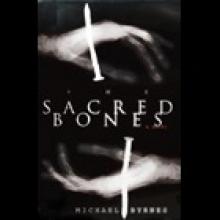 The Sacred Bones
The Sacred Bones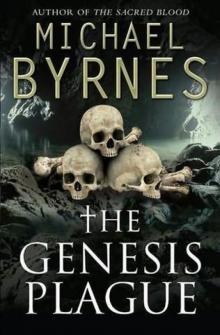 The Genesis Plague (2010)
The Genesis Plague (2010)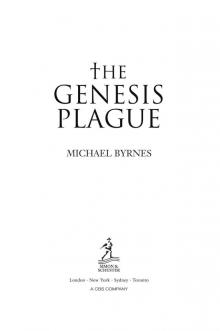 The Genesis Plague
The Genesis Plague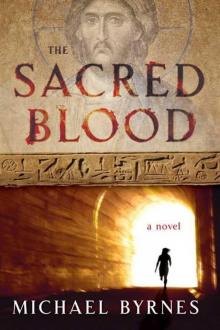 The Sacred Blood
The Sacred Blood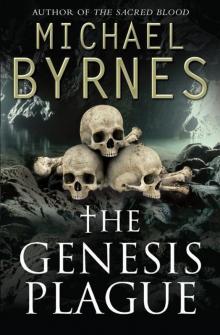 The Genesis Plague tf-1
The Genesis Plague tf-1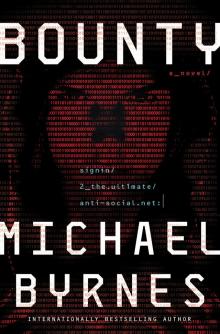 Bounty
Bounty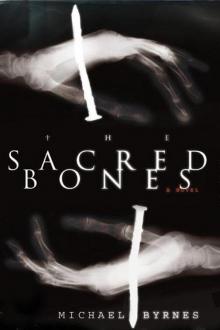 Sacred Bones : A Novel
Sacred Bones : A Novel